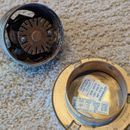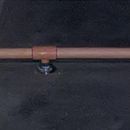Seeking to air seal concealed sprinkler heads. This a bit scarry.
Ok, I’m working on a large residential system with unvented cathedral ceilings. It’s got can lights into the cavities, but more importantly dozens of sprinkler heads. Each is an gross air leak into the unvented cavities.
They don’t look easy to seal. Each has a decorative cover held on by three tabs, which must be able to drop free via gravity. No caulk there.
We’ve got the NFSA saying, in short, don’t do it
It references Jeff Hugo’s article from the 2012 Nov/Dec edition of the National Fire Sprinkler Magazine titled, “Caulking Fire Sprinklers for Energy Code Compliance,” but the article doesn’t seem to be available online.
Table R402.4.1.1 states, “concealed fire sprinklers shall only be sealed in a manner that is recommended by the manufacturer. Caulking or other adhesive sealants shall not be used to fill voids between fire sprinkler cover plates and walls or ceilings.” yet “There are many code compliant methods to properly seal the sprinkler penetrations. Insulation contractors need to have special concern to ensure the air sealing product system is compatible to non-metallic piping materials.”
And the CVPC vendors are quick to warn various products and even cooking oil can cause leaks in CVPC sprinkler pipe (such as Blazemaster). See Other Compatibility Topics from Lubrizol. https://www.lubrizol.com/CPVC/FBC-System-Compatible-Program/Other-Compatibility-Topics
I’m left with so many questions.
So posting here in hopes the hive mind can figure this all out, or surface more resources.
GBA Detail Library
A collection of one thousand construction details organized by climate and house part











Replies
The head itself has to be in the conditioned space so that it can detect the heat of a fire. So the air barrier has to be behind the head. I'm thinking a tent made of some sort of air barrier -- Membrain, Tyvek, poly sheet -- that is taped to the drywall and then goes over the sprinkler pipe, with a little origami to seal the edges.
How are you insulating the cavity?
For the pictured head, Tyvek origami is all good (as long as the tape is listed compatible with CPVC BlazeMaster pipe). There will be no insulation above: that's a dead airspace below an insulated roof.
Many of the other heads are accessible only from the active side. The heads are designed to be replaceable using a special tool, and it should be noted have a relatively fragile trigger. In my case these heads go into vented or unvented inaccessible cathedral ceiling cavities.
I would bet the 3M fireblock spray foam -- the orange stuff -- is suitable, but you'd have to read the label. Then you'd have to make something that goes between the head and the drywall to contain the foam. I'm thinking a paper cup with a slit cut in it so you can slide it over the head, then tape the slit shut.
The 3M product may or may not be listed for BlazeMaster: but spray polyurethane foam is so there's hope.
The challenge with the paper cup approach is note how the metal of the sprinkler head is deliberately open in the back. Getting the cup to seal against pressure of the spray foam seems a tall order, and the solution definitely can't intrude into the metal cup of the sprinkler head.
severaltypesofnerd,
What does the un-vented roof assembly consist of? Most of the common ones don't rely on a warm-side air-barrier. How important is it that the ceiling penetrations be air-sealed?
Is this one of the times when the consultant collects money to find the diplomatic way of saying no you can’t do what the customer desperately wants to do?
You may want to reread this article
https://www.greenbuildingadvisor.com/article/five-cathedral-ceilings-that-work
When customer insist on having pot lights and sprinklers in the cathedral ceiling the only way to get the code minimum R value is to move the insulation to the exterior.
Walta
That's the way a consultant gets fired, if the building is already 20 years old, and the decisions were made poorly then.
In part of this building the insulation IS on the exterior, but the sprinkler pipes were carve outs for the solid foam (5.25" in chat case). The building has 5 different roof types, so there's really some of each to pick from ;-)
These all accessible from above (within reason) like the photo? For can lights there is overpriced covers for the backside. Given that you have no heat concerns and this is just for air sealing, something like this could work. Pull the soft foam off, cutout for the pipe to pass through, fireblock foam to hold it to the drywall lid and seal up the cutouts for the pipe.
https://www.menards.com/main/plumbing/pipe-insulation-heat-cables/deicers-heat-cable-accessories/frost-king-reg-outdoor-faucet-cover/12200/p-1444444948808-c-8587.htm
Sounds like another argument for an unvented attic. And another way to get conditioned air into one (planned or not).
The reverse of this question is that you want an air seal to keep particulates from dropping down through the sprinkler opening - especially for those of us using loose blown cellulose! If the pipe and sprinkler head are wrapped in something protective you could probably seal the whole thing on the attic side with air duct mastic. The wrapping would give you hope of prying it off in 20 years when a fitting needs replacing as well as protecting the pipe from chemicals in the mastic.